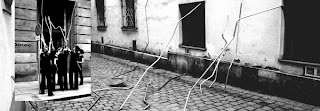Monday, 21 November 2011
ARCHITECTURE OF ENERGY- Lebbeus Woods
Any city is comprised of many systems—economic, technological, social, cultural—which overlay and interact with one another in complex ways. Each system is different, but from one point of view all share a common purpose–the organization of energy—and a common goal—giving the cumulative energy of the city a coherent form.
According to Maxwell’s second law of thermodynamics, the entropy in a system will increase (it will lose energy) unless new energy is put in.
According to Newton’s law of inertia, a system will stay at rest unless it is disturbed by an external force.
Energy exists in two states: kinetic and potential. A brick sits on top of a wall—potential (it could fall). A brick is pushed from the top of the wall—kinetic (its potential is released).
Energy takes many forms, each created by a system that contains it for a particular purpose. Architecture is one such system that contains energy by establishing stable boundaries, limits, edges. New energy—in the form of maintenance—must continually be added to the system of materials, or they will decay. Metaphysically speaking, new energy—in the form of human thought, emotion, activity—must continually be added to the system of boundaries, or they will lose their purpose and meaning.
The first task of experimental works of architecture and art is to stake out new points of view on what already exists. The second task is to test them.
“What exactly do the vectors represent?”
“They don’t represent anything. They are just themselves—embodied energy.”
“They contain energy?”
“Yes. Can’t you see it?”
“I see white lines on a black surface.”
“Tell me, what do you see when you look at that building? Bricks, windows, metal, glass?”
“Yes.”
“That’s all?”
“Yes.”
“Ah, then that’s the problem. You can’t see energy, just its effects.”
……..
“The vectors contain the energy that it took to make them. It is a measurable amount of energy, but it has not yet been measured. It consists of physical energy, intellectual and emotional energy. Certainly we will be able to measure it by its effects, if and when there are any.”
“So, then, the vectors are a form of energy?”
“Yes, that is what they are.”
“Well, there’s nothing new there. Any drawing, any word or act has the potential to have an effect. All you’re doing is seeing it differently.”
“Exactly!”
http://lebbeuswoods.wordpress.com/2009/06/05/architecture-of-energy/
Subscribe to:
Post Comments (Atom)






No comments:
Post a Comment